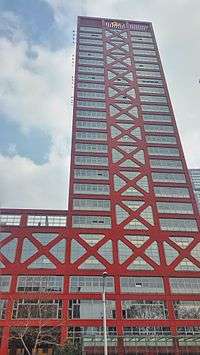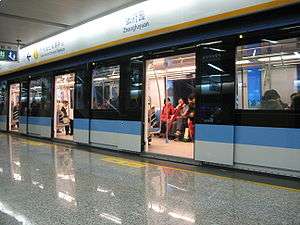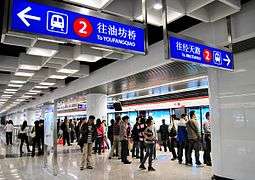Nanjing Metro
|
| |||
|
| |||
|
A Line 1 train at Sanshan Street Station | |||
| Overview | |||
|---|---|---|---|
| Locale | Nanjing, China | ||
| Transit type | Rapid transit | ||
| Number of lines | 7 metro lines | ||
| Number of stations | 139 | ||
| Daily ridership |
1.96 million (2015 avg.) 2.9962 million (2016 record)[1] | ||
| Annual ridership | 717 million (2015)[1] | ||
| Operation | |||
| Began operation | 3 September 2005 | ||
| Number of vehicles | 202 trains | ||
| Technical | |||
| System length | 260.5 km (161.9 mi) | ||
| Track gauge | 1,435 mm (4 ft 8 1⁄2 in) standard gauge | ||
| Electrification | 5 kV DC overhead lines | ||
| |||
| Nanjing Metro | |||||||
| Simplified Chinese | 南京地铁 | ||||||
|---|---|---|---|---|---|---|---|
| Traditional Chinese | 南京地鐵 | ||||||
| |||||||
The Nanjing Metro is the metro system serving the urban and suburban districts of Nanjing, the capital city of Jiangsu Province in the People's Republic of China. The system has seven lines and 128 stations running on 257 km of track. It is operated and maintained by the Nanjing Metro Group Company. The total length of the system ranks fifth in China, after Shanghai, Beijing, Guangzhou and Shenzhen. In 2015, the metro system carried a total of 720 million annual riders.[2]
Proposals for a metro system serving Nanjing first began in 1984, with approval by the State Planning Commission granted in 1994. Construction began on the initial 16-station Line 1, Nanjing Metro in 1999, and opened in 2005. Future expansion plans include three lines set to open within the next few years, with several more awaiting approval to begin construction.
History
First proposals
In 1984 the first serious proposal for construction of a subway appeared in the Municipal People's Congress.[3] On April 1986, the Nanjing Integrated Transport Planning group was established to research on how to implement a subway system in Nanjing. On December 1986 the team published the "Nanjing Metro Initial Phase". The phase consists of a north–south line, east–west line and a diagonal Northwest to Southeast line. The three lines meet in the city center forming a triangle.[4] A revision of the "Nanjing City Master Plan" in 1993 added another line through the urban core, and three light metro lines connecting Nanjing's suburbs in Pukou and the proposed new airport. In addition a suburban railway to Longtan was proposed. A 1999 report on "Nanjing city rapid rail transit network planning" further proposed six subway lines, two subway extensions and three light metro lines.[5]
In 1994, the State Planning Commission approved the preparatory work for the subway only to have the entire metro project postponed in 1995 amid a national freeze on new metro projects.[6]
Major changes were made to "Nanjing Urban Rail Transit Network Planning" in 2003. The new master plan consisted of 13 lines, of which nine are subway lines and four are light metro lines. The new Line 6 will be a loop line connecting all the urban radial lines. The plan retained the original lines 1, 2 and 3 from the previous plan. According to the new plan, the initial phase would consist of the completion of Metro Line 1 and 2 by 2010. Together the two lines will form a basic "cross" network. By 2020 the completion of Lines 1, 2, 3, and 4 was to form a more robust "pound" (#) network. Longer term plans include the construction of a loop line connecting all existing lines. The plan also identified four subway lines crossing the Yangtze river.
First line
The initial section of Line 1 from Maigaoqiao to Xiaohang received final official approval in 1999. In May 2000, the Experimental Station resumed construction with the entire Line 1 project in full construction in December.
A western extension of Line 1 from Xiaohang to a newly built stadium was fast tracked after Nanjing won hosting the National Games. Line 1's initial section and the western extension started trial operations in September 3, 2005, running from Maigaoqiao to Olympic Stadium with 16 stations and a total length of 21.72 kilometers (13.50 mi).[3] The opening of the Nanjing Metro Line 1 gave Nanjing the sixth metro system in the Chinese mainland after Beijing, Tianjin, Shanghai, Guangzhou and Shenzhen.
Current system


| Line | Terminals | Opened | Length (km) | Stations | |
|---|---|---|---|---|---|
| 1 | Maigaoqiao (迈皋桥) | China Pharmaceutical University (中国药科大学) | 2005 | 37.9 | 27 |
| 2 | Youfangqiao (油坊桥) | Jingtianlu (经天路) | 2010 | 38 | 26 |
| 3 | Linchang (林场) | Mozhoudonglu (秣周东路) | 2015 | 44.9 | 29 |
| 4 | Longjiang (龙江) | Xianlinhu (仙林湖) | 2017 | 33.5 | 18 |
| 10 | Andemen (安德门) | Yushanlu (雨山路) | 2014 | 21.6 | 14 |
| Subtotal | 176.06 | 114 | |||
| S1 | Nanjing South Railway Station (南京南站) | Nanjing Lukou International Airport (禄口机场) | 2014 | 35.8 | 8 |
| S8 | Taishanxincun (泰山新村) | Jinniuhu (金牛湖) | 2014 | 45.2 | 17 |
| Total | 257.2 | 139[Note 1] | |||
Line 1
Line 1 runs mainly in a north–south direction. The line starts at Maigaoqiao station in the north, heading southwards to CPU (China Pharmaceutical University). The construction of Line 1 began in the year 2000 and was inaugurated on September 3, 2005, with 16 stations and a length of 21.72 kilometers (13.50 mi).[7] On May 28, 2010, Line 1's 24.5-kilometer (15.2 mi) long south extension entered into operation.[8][9] Thus, before the transfer of Line 1's Olympic Sport Center Branch to Line 10, Line 1 was 46.2-kilometer (28.7 mi) long with 31 stations. The Olympic Sport Center branch line broke away from Line 1 and formed parts of Line 10,[10] when the latter's construction finished and entered operation in July 1, 2014. Currently, Line 1 is 38.9-kilometer (24.2 mi) long and has 27 stations.[11]
Line 2
Line 2 is 37.95-kilometer (23.58 mi) long and has 26 stations.[12] It runs mainly in an east–west direction, from Youfangqiao Station in the southwest to Jingtianlu Station in the northeast. It entered into operation on May 28, 2010.[8][9]
Line 3
Groundbreaking work for Line 3 started in January 2010. This line, with a north–south orientation, started operation on April 1, 2015[13] and is 44.9 kilometres (27.9 mi) in length with 29 stations.[14]
Line 4
Construction of east-west Line 4 was begun in late 2012[15] and the first phase entered operation on January 18, 2017. The completed portion is 33.75 kilometers (20.97 mi) in length.[16]The line is known as A Zi (the Purple) as the branding for the line and the train color is purple, the first of which were delivered in April 2015.[17] The line started operation on January 18, 2017.[18]
Line 10
Line 10 is a western extension from Line 1's Olympic Stadium branch line, which broke away from Line 1 and formed part of Line 10 when the new line was completed. Construction started in February 2012,[19] finished in 2014. The line is approximately 21.6-kilometer (13.4 mi) long with 14 stations,[20] and entered operation in July 1, 2014.[21]
Line S1
Originally called Metro Line 6, Line S1 or the Ninggao Intercity Rail Line acts as Nanjing's airport express line, connecting Nanjing South Railway Station to Gaochun District via Nanjing Lukou International Airport. The entire line was planned to be 85.8-kilometer (53.3 mi) long with 13 stations.[22] The first phase from Nanjing South to Lukou International Airport started construction in December 27, 2011, and finished in 2014. The first phase opened in July 1, 2014. It is 35.8-kilometer (22.2 mi) long with 8 stations.[23] Advanced signalling and urban rail traffic management systems were delivered to the line in time for the Nanjing 2014 Summer Youth Olympics by Thales Saic Transportations. A second phase extension totaling 52-kilometer (32 mi) is expected to open in 2016.[24]
Line S8
Originally planned as Metro Line 11, Line S8 or the Ningtian Intercity Rail Line is an intercity metro line connects Luhe District to Pukou District. The Line is 45.2-kilometer (28.1 mi) long,[25] 34.1 kilometers (21.2 mi) of the line is elevated. The line features 17 stations[25] including 6 underground stations and 11 elevated ones. It uses B size trains in 4 car sets that are capable of running up to 100 kilometers per hour (62 mph). Construction of the line started on June 21, 2012 and it was officially opened on August 1, 2014.[26][27]
Under-construction projects

Line 5
Line 5 received approval on 14 January 2015.[28] Before the relocation in 2017, the line is projected to be 37.4 kilometers (23.2 mi) long, containing 29 stations and to cover a route from Fangjiaying Station in Gulou District to Jiyindadao Station in Jiangning District.[29]
Line S3
Line S3 is expected to open in November 2017.[30] Originally planned as Metro Line 12 or the Ninghe Intercity Rail Line, the route started construction in late 2011 as a connection between urban Nanjing and He County in neighboring Anhui Province.[31][32] Phase one will be 37.53 kilometers (23.32 mi) long with 19 stations[33] and will connect Nanjing South Railway Station to Jiangbei New Area in Pukou.[30]
Line S9
Line S9 is an extension of line S1 (Airport Line) that will start from Xiangyulunan station; the 6th station from Nanjing South Railway Station, and extend further south, to Gaochun District, for the total length of 85.8 km.[34]
Ticket system
Like many metro systems in the world, fares on the Nanjing Subway are distance-based. Fares range from 2 yuan (approx USD $0.30) for journeys under 8 stations, to 4 yuan for longer journeys.[35] There is a 5% discount for users of the Nanjing Public Utility IC Card.
Single tickets
Single journey tickets can be purchased from the ticket vending machine or at a ticket window. The ticket vending machine accepts both coins and bills (¥5 and ¥10).
Transit card
Apart from one-way tickets, fares can be paid with the Nanjing Public Utility IC Card, or Jinlingtong (Chinese: 金陵通; pinyin: Jīnlíngtōng). It can be purchased for a refundable fee of 25 yuan (about 3.8 dollars) and refilled at ticket booths inside the metro stations as well as many collaborative convenience stores throughout the city. The card can be used to pay for other means of public transportation, such as the city taxi and the city bus.
This transit card is similar to Beijing's Yikatong, London's Oyster Card, Chicago Card of the CTA, the SmarTrip of the Washington Metro, and the Octopus card of Hong Kong's MTR.
Rolling stock
- 20 six-car Alstom/Nanjing Puzhen Rolling Stock Works Metropolis sets - ordered in 2002 for Line 1 opening.[7]
- 21 six-car Alstom/Nanjing Puzhen Rolling Stock Works Metropolis ordered January 2008 for Line 1 extension.[8]
- 24 six-car Alstom/Nanjing Puzhen Rolling Stock Works Metropolis cars ordered 2007 for Line 2.[36]
- 26 four-car Alstom/Nanjing Puzhen Rolling Stock Works Metropolis cars ordered 2013 for Line S8.[37]
- 29 six-car Alstom/Nanjing Puzhen Rolling Stock Works Metropolis cars ordered 2013 for Line 4.[38]
Signaling system
For Line 1, Siemens Transportation Systems (TS) was awarded the supply contract in November 2002.
For Line 2, Siemens Transportation Systems (TS) and its local partner Nanjing Research Institute of Electronic Technology (NRIET) have been awarded to supply the signaling system after signing a contract (about 25 million Euro). Technologies used include Trainguard MT, Vicos OC 501, Sicas ECC and Az S 350 U axle counting system.[39]
Gallery
 A Line 1 train approaching Hongshan Zoo Station
A Line 1 train approaching Hongshan Zoo Station A train stops at Zhangfuyuan Station
A train stops at Zhangfuyuan Station The Line 2 platform of Xinjiekou Station
The Line 2 platform of Xinjiekou Station-2.jpg) A line 2 train
A line 2 train A Line 3 train leaving Linchang Station
A Line 3 train leaving Linchang Station.jpg) A line 10 train approaching Xiaohang Station
A line 10 train approaching Xiaohang Station A view in Line 10 train carriage
A view in Line 10 train carriage A Line S8 train
A Line S8 train
See also
References
- 1 2 南京地铁国庆前一天客流299.62万乘次创历史新高. 扬子晚报网 (in Chinese). 2016-10-01. Retrieved 2016-10-04.
- ↑ "南京地铁全年载客7.2亿人次 比上年猛增43%" [Nanjing subway annual ridership of 720 million passengers up 43% from previous year] (in Chinese). People's Daily. February 17, 2016. Retrieved December 21, 2016.
- 1 2 "南京地铁二十年梦圆". 扬子晚报. 2005-04-30.
- ↑ 彭长生 (1993). "南京地铁一期工程与轨道交通规划". 都市快轨交通 (03).
- ↑ 何宁,杨涛 (27 April 2005). "南京城市轨道交通规划:二十年规划 宏图变通途". 南京日报.
- ↑ 国务院办公厅. "国务院办公厅关于暂停审批城市地下快速轨道交通项目的通知". 1995年12月28日. 中央政府网. Retrieved 2014-10-04.
- 1 2 "Nanjing metro inaugurated". Railway Gazette International. 1 October 2005. Retrieved 2014-07-03.
- 1 2 3 "Nanjing Metro places €85·5m train order". Railway Gazette International. 25 January 2008. Retrieved 2014-07-03.
- 1 2 南京地铁二号线载人模拟运营]. Sina News (in Chinese). Retrieved 2010-05-25.
- ↑ 地铁1号线四站将于6月1日起开始割接 [Four Stations of Metro Line 1 will start from June 1 cutover] (in Chinese). 南京地铁官方网站 [Nanjing Metro official website]. 29 May 2014. Retrieved 2014-07-03.
- ↑ 1号线 [Line 1] (in Chinese). 南京地铁集团有限公司 [Nanjing Metro Group Co., Ltd.] Retrieved 2015-07-09.
- ↑ 2号线 [Line 2] (in Chinese). 南京地铁集团有限公司 [Nanjing Metro Group Co., Ltd.] Retrieved 2015-07-09.
- ↑ "Nanjing metro Line 3 opens". Railway Gazette International. 2 April 2015. Retrieved 2015-04-04.
- ↑ 3号线 [Line 3] (in Chinese). 南京地铁集团有限公司 [Nanjing Metro Group Co., Ltd.] Retrieved 2015-07-09.
- ↑ "南京地铁4号线年底前开工". China Daily. 5 September 2012. Retrieved 2012-10-07.
- ↑ "南京地铁4号线主城“横贯线” 连创多个第一" [Metro Line 4, central city's "east-west line" achieves multiple firsts] (in Chinese). Nanjing Daily News. January 18, 2017. Retrieved January 18, 2017.
- ↑ "First Trainset of Nanjing Metro Line 4 Unveils". Nanjing China. 2 April 2015. Retrieved 2016-05-28.
- ↑ 1453. "南京地铁4号线“阿紫”开通试运营--图片频道--人民网". pic.people.com.cn (in Chinese). Retrieved 2017-01-19.
- ↑ 南京地铁三号线暨一号线西延过江线试验段开工 [Nanjing Metro Line Line 1-cum-west extension line test section over the river started]. www.ce.cn (www.chinaeconomy.cn) (in Chinese). 11 January 2010. Retrieved 2010-05-25.
- ↑ 10号线 [Line 10] (in Chinese). 南京地铁集团有限公司 [Nanjing Metro Group Co., Ltd.] Retrieved 2015-07-09.
- ↑ 南京地铁10号线、机场线明晨6点通车 运营时刻早知道 [Nanjing Metro Line 10, the opening of the airport line tomorrow morning 6:00 to be operational at that time]. 扬子晚报网 [Yangzi Evening News Network] (in Chinese). 30 June 2014. Retrieved 2014-07-03.
- ↑ 地铁机场线、宁天城际一期工程传新动态 [Metro airport line, intercity one day pass new dynamic project]. www.HOUSE365.com (in Chinese). 26 April 2012. Retrieved 2014-07-03.
- ↑ S1号线 [Line S1] (in Chinese). 南京地铁集团有限公司 [Nanjing Metro Group Co., Ltd.] Retrieved 2015-07-09.
- ↑ "2nd Phase of Metro Line S1 be in Construction". Nanjing China. 21 January 2016. Retrieved 2016-05-28.
- 1 2 S8号线 [Line S8] (in Chinese). 南京地铁集团有限公司 [Nanjing Metro Group Co., Ltd.] Retrieved 2015-07-09.
- ↑ 大桥北路到金牛湖将只要半小时. 南京日报.
- ↑ 宁天城际一期开工 青奥会前通车. 南京日报.
- ↑ "Nanjing Metro Line 5 MoU Signed". Railway Gazette International. 16 January 2015. Retrieved 2016-05-28.
- ↑ "Plan on Nanjing Metro Line 5 Approved". Nanjing China. 21 February 2016. Retrieved 2016-05-28.
- 1 2 "17 Stations of Nanjing Metro Line S3 Mainly Completed". Nanjing China. 10 May 2016. Retrieved 2016-05-28.
- ↑ "Alstom to Support the Metro Development of Nanjing". Railway News. 10 September 2014. Retrieved 2016-05-28.
- ↑ 12号线变身“宁和城际” Archived October 29, 2011, at the Wayback Machine.
- ↑ http://www.yangtse.com/nanjing/2017-07-05/1287042.html
- ↑ "宁高城际简介". 南报网 (in Chinese).
- ↑ "Public Transportation". Nanjing China. 26 March 2014. Retrieved 2016-05-28.
- ↑ "Shanghai and Nanjing order cars". Railway Gazette International. 1 June 2007.
- ↑ "Nanjing SR Puzhen Rail wins metro rail deal in China". Railway Technology. 8 February 2013. Retrieved 2016-05-28.
- ↑ "Nanjing SR Puzhen to deliver 174 train cars to Nanjing Metro Line 4 in China". Railway Technology. 6 June 2013. Retrieved 2016-05-28.
- ↑ "Siemens to supply advanced signaling and control systems to Nanjing Metro Line 2". Siemens AG. 20 April 2007. Retrieved 2008-06-30.
- ↑ This figure involves counting the two interchanges once for every line that it is part of. If every interchange is only counted once, there will be 128 stations.
External links
| Wikimedia Commons has media related to Nanjing Metro. |
- Nanjing Metro – official website (in Chinese)
- Nanjing at UrbanRail.net


